C&S Water Tank at Blackhawk and the "Three Bent Water Tanks".
1234




















1234
Re: C&S "One Bent / Two Pier" Tank?
|
Well . . . I certainly didn't see that coming. Thanks, Chris, 'splains a lot.
But I dunno South Park, in the second Riverview tank photo that I posted (the c1910 photo with the light tank at a near right angle in silhouette) to my eye there is a visible end to a cap member visible, between the hillside and the front edge of the tank floor, suggesting at least one bent of posts. So maybe Riverview should be classed as a "One Bent / Two Pier Tank" 
Jim Courtney
Poulsbo, WA |
Re: C&S "Three Bent Tanks" -- Riverview??
|
This post was updated on .
In reply to this post by Jim Courtney
Jim,
Starting with your third Riverview photo, the geometry is difficult because of the skew angle of the view. The height of the 27 ft boxcar side is the easiest known dimension to use as a scale factor, and with this I get the tank diameter and height as 16.5' x 12.5' which comes out to just about 20,000 gal. Note that this is a tapered tank. The first photo of the tank behind the engine gives a similar result, but it's also a difficult one, it would take extensive calculations to scale the depth of the scene precisely. I can make a pretty good estimate by using the fact that the tender is taking on water, though, and thus using the standard 9' dimension from tank feed to the track centerline, I get that the tank is a small amount larger than 16' x 12', so that is consistent with the first result. The second photo of the later tank is a tough one. Best I can do is that the view is fairly nearly side-on to the spout. Then I can scale again from an assumed 9' length of spout, giving a 20' tank diameter and about 15' height, which is indeed consistent with your suggestion that this is a standard 30,000 gal tapered tank. John
John Greenly
Lansing, NY |
Re: C&S "Three Bent Tanks" -- More Tunnel Gulch
|
In reply to this post by Jim Courtney
Otto Perry made a couple of photos of the tank at tunnel Gulch in 1943. Wonder how he got the gas ration to drive to this remote spot during WW2?
http://digital.denverlibrary.org/cdm/fullbrowser/collection/p15330coll22/id/44085/rv/singleitem/rec/12  http://digital.denverlibrary.org/cdm/singleitem/collection/p15330coll22/id/44086/rec/9  Otto referred to the tank as the "Woodstock Tank".
Jim Courtney
Poulsbo, WA |
Re: C&S "One Bent / Two Pier" Tank?
|
In reply to this post by Jim Courtney
So maybe Riverview should be classed as a "One Bent / Two Pier Tank"
Jim, there is no framed timber bent support visible in either iteration of the Tank, I'd be thinking that two concrete supports with a third (missing) timber mudsill at the rear was most likely. Notice the large protruding rocks to the East have disappeared over time, yet the rocks supporting the poured foundation still remain, thus indicating that the Tank was well supported without a framed Bent out front.
UpSideDownC
in New Zealand |
Re: C&S "Three Bent Tanks" -- More Tunnel Gulch
|
In reply to this post by Jim Courtney
The second Perry photo gives a slightly better look at the Tunnel Gulch tank bent bracing. Looks to me as if there are only two pairs of big double diagonal braces between the two outer bents. I don't see any going the other way except the small ones up at the top of the posts. And it does look like there is a third post- or maybe an inner pair of posts- in the center bent. Does that look right to you?
The Blackhawk tank doesn't have those small upper braces, but I think there might be a diagonal plank brace on the righthand side of the center bent. Here's an enlargement of Jim's photo, I've added a double line parallel to (to the right of) the feature I'm looking at: 
What do you think? John
John Greenly
Lansing, NY |
Re: C&S "One Bent / Two Pier" Tank?
|
This post was updated on .
In reply to this post by Chris Walker
Okay, Chris, I see where you're going now.
When I looked at the Google street view, I saw only two concrete piers on rock. Since the one closest to the asphalt pavement seems wider than the one behind, I took that to be the center pier. If so, it would seem a bent would be necessary in front of the near pier (  ) to support the front of the tank (I assumed the modern road to be wider than the RR right-of-way). ) to support the front of the tank (I assumed the modern road to be wider than the RR right-of-way).
I see now that you read the nearest pier to be supporting the front of the tank. A third pier (or timber mud sill) may be behind the two visible piers, covered with earth that has eroded down the hill side. Riverview tank would make a great diorama. Once the rock work and supporting piers are in place and level, two different tanks for two different eras could be interchangeable. (ie 1902 and 1910-1920). I'm trying to figure out how the tank sat on the piers. I enlarged Derrell's posted photo of 1902 and it helps a bit: 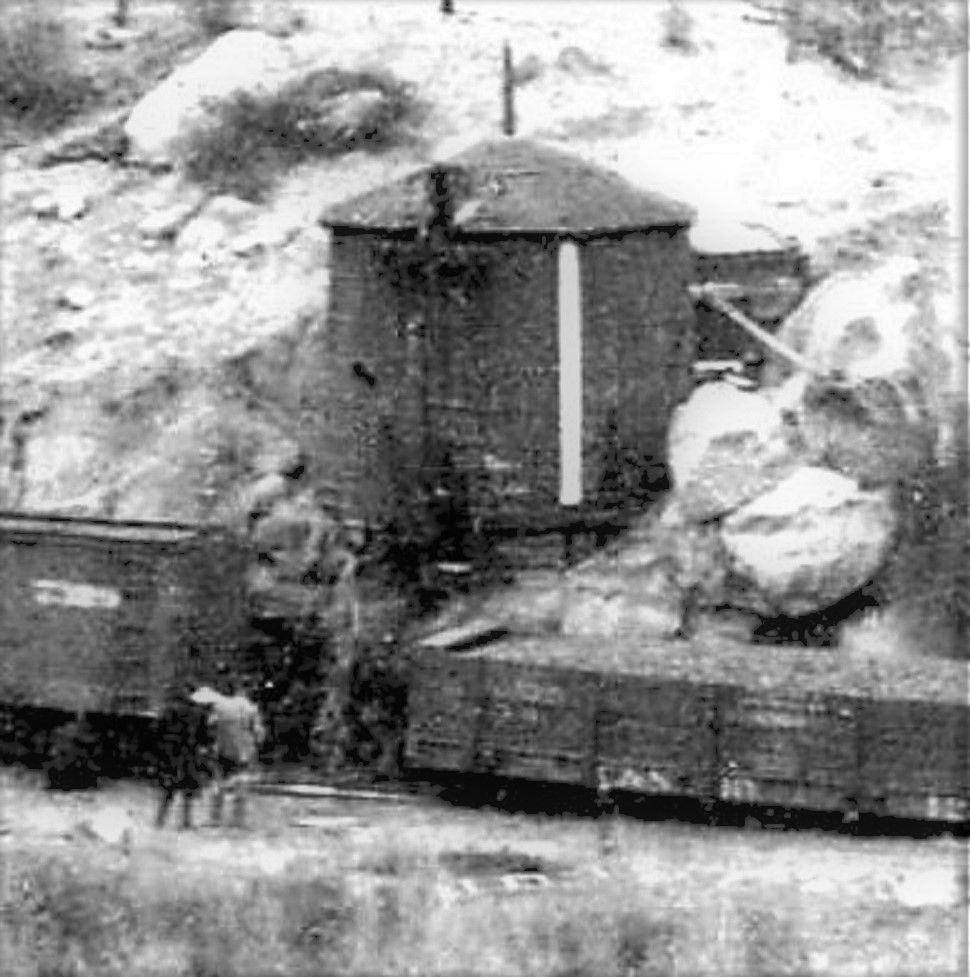 Maybe I'm cross-eyed, but I see another layer of structure above the concrete pier. I'm trying to reconcile it with typical C&S tank construction. The closeup of Tunnel Gulch that Ken Martin posted (as linked up thread) helps a bit: 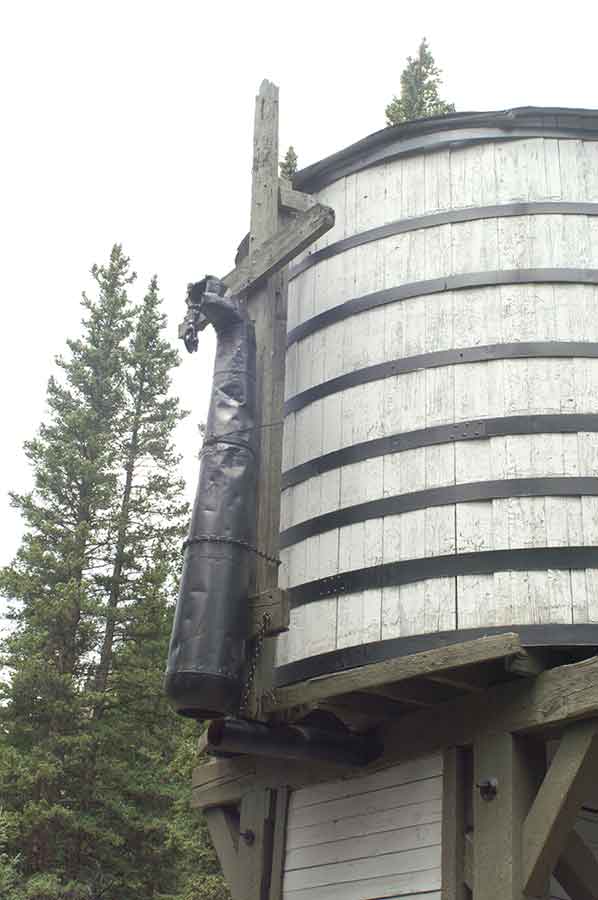 With those details in mind, this is my read on the Riverview tank:  I'd appreciate any and all feedback from the railroaders, engineers, architects and contractors out there -- baby doctors can copy and build what they see, but don't always understand what they are seeing. Copy and save the enlargement of Derrell's photo, upload into "Paint", then label what you think all the things are in the blurry enlargement. 
Jim Courtney
Poulsbo, WA |
Re: C&S "Three Bent Tanks" -- More Tunnel Gulch
|
In reply to this post by John Greenly
John,
Ken Martin's color photo of the restored tunnel Gulch Tank (linked up thread) is the most helpful, I think: 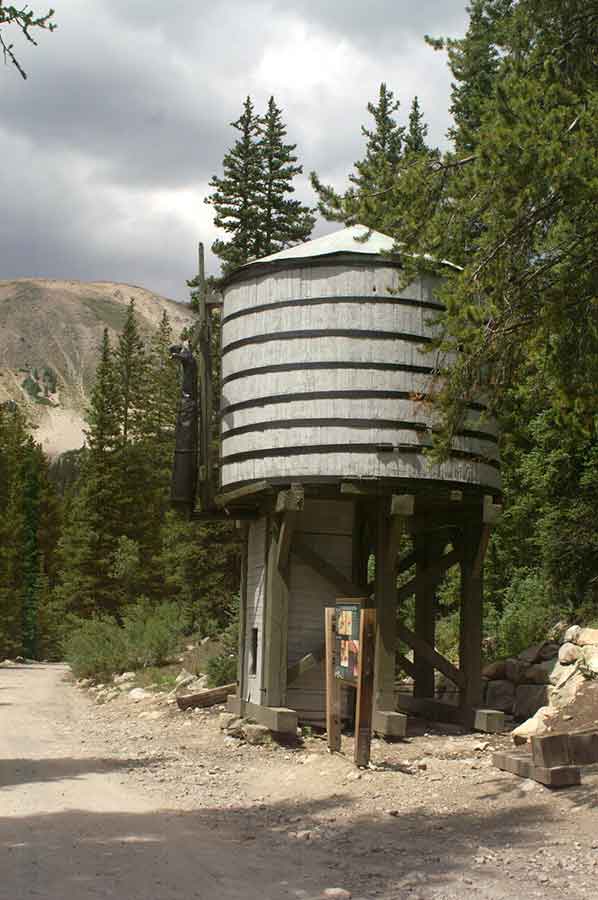 The outside bents are two posts only. The x-shaped pair of knee braces (?) attach to the inside surfaces of the outside posts. I see three posts on the center bent. The frost box side and rear walls are flush against the inside center post and inside the two outer posts. Anyway, that's my take. I see what you mean about a diagonal brace spanning the three center posts at Blackhawk.  I don's see any evidence of the horizontal tie rods between the front and rear pair of posts, like in Ken's detail of Tunnel Gulch.
Jim Courtney
Poulsbo, WA |
Re: C&S "One Bent / Two Pier" Tank?
|
In reply to this post by Jim Courtney
Jim,
With those details in mind, this is my read on the Riverview tank: I think you are correct with what you see there as you have it labeled. I don't have a photo, since I used to go past it so often but near here is a W.T. built two supports on concrete above rock with the front Bent of timber. I flogged this snap of a youtube movie to illustrate, the highway through this gorge is now closed so I can't go. We didn't use Spouts often NZR preferring a canvas tube to fill the Tenders/tanks.  ps Drop me an Email please.
UpSideDownC
in New Zealand |
Re: C&S "One Bent / Two Pier" Tank?
|
In reply to this post by Jim Courtney
Jim, thanks for reminding me of Ken's posted Tunnel Gulch photo, that is great help.
As to Riverside, I'll point out one thing to add to your thoughts. If we believe my measurements, the early tank was 16-17 ft diameter, and and the later one 20 ft diameter. Assuming both of them did have the usual 9 ft spouts, the early one would have not have been as far back into the hillside as the later one- the back of the large one would have been 3-4 ft further back into the slope. The early tank appears to me to be quite a snug fit to the excavation in the hillside. I wonder if that had to be reworked and enlarged for the later, larger tank- if so, then the present-day evidence may not be much help with respect to the early tank. The concrete piers may not have been there at all until the second tank went in. As to the photograph-- I think you're right about the position of the tank bottom, and as to the rest, your interpretation looks reasonable, but I'm afraid it's one of those cases where no matter how hard I squint, I can't see any better. John
John Greenly
Lansing, NY |
Re: C&S "One Bent / Two Pier" Tank?
|
In reply to this post by Jim Courtney
Well, Riverview just goes to show there is a prototype for everything!
 If I saw this on a layout, I would swear someone was making it up. Now we know. And it is so easy to spy on Google Maps, too these eighty years later. (...now what kind of band fasteners did the tank have?)
Keith Hayes
Leadville in Sn3 |
Re: C&S "One Bent / Two Pier" Tank?
|
...now what kind of band fasteners did the tank have?
I plan on using the fasteners in Banta's "Baker Tank" kit. When you find me a clear, closeup photo of Riverview tank, I'll change them, if need be. 
Jim Courtney
Poulsbo, WA |
Re: C&S "No Bent Tank" -- Riverview
|
In reply to this post by Chris Walker
One more photo of Riverview Tank.
Sadie George took a similar photo in the Summer of 1914. Not much in the way of new information, except by that date the tank seems to have been repainted CB&Q red. 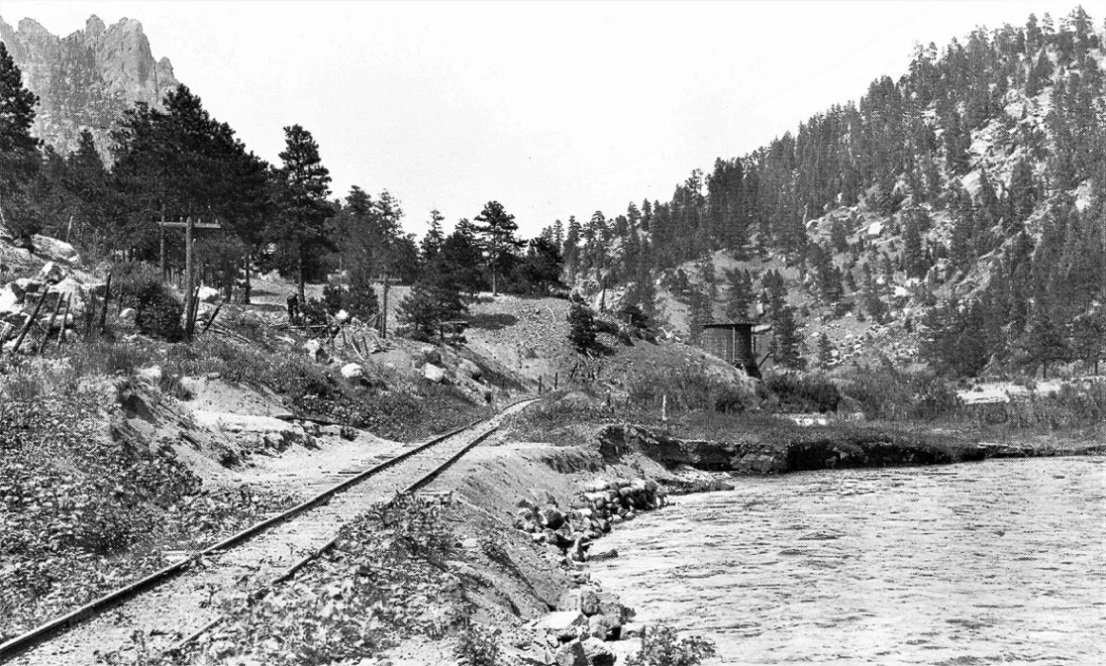 In the Klingers' Platte Canon Memories . . . Enlarging doesn't help much. What I mistook as a front bent, I guess is the concrete pier and a timber sill on end (arrow).  The lady took some great photographs.
Jim Courtney
Poulsbo, WA |
Re: C&S "No Bent Tank" -- Riverview
|
Derrell's Buffalo layout includes Riverview and the tank.Look at the Blog.
|
Re: Kenosha -- Ghost of C&S "Three Bent Tank"?
|
This post was updated on .
In reply to this post by Jim Courtney
I ran across this familiar image on eBay:
https://www.ebay.com/itm/Colorado-Southern-C-S-Engine-73-at-the-Kenosha-Pass-Co-in-1938-8x10-Photo/302837997367?hash=item46828d1f37%3Ag%3A3aAAAOSw54xUVe4P&_sop=10&_nkw=colorado+%26+southern&_sacat=35975&rt=nc&LH_TitleDesc=1 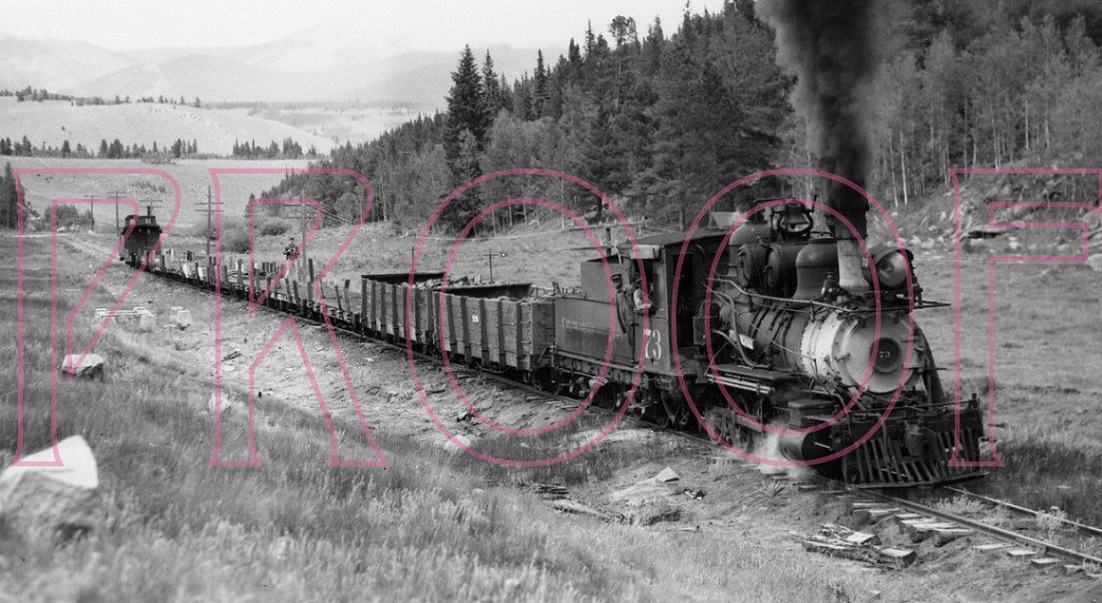 C&S 73 is heading a westbound scrapper's supply train, about to crest Kenosha summit, just east of the little lake at the top of the grade. This photograph has been attributed to both Jackson and Gibson (maybe both shot the same view, they were traveling together that day). I've admired this photo in my books for years. Every time I leave the parking area at the top of the pass, and begin the drive back east toward Denver, I glance off to the right and imagine number 73 about to crest the summit. This eBay image is of better resolution than any of my books and I noticed something that I hadn't before: Just to the left of the second flat car in the consist is a group of piers, arranged in three rows, to my eye two in front and back and three, maybe four, in the middle. So I wondered, could these be piers for an abandoned "three bent tank" that once served the summit at Kenosha?? 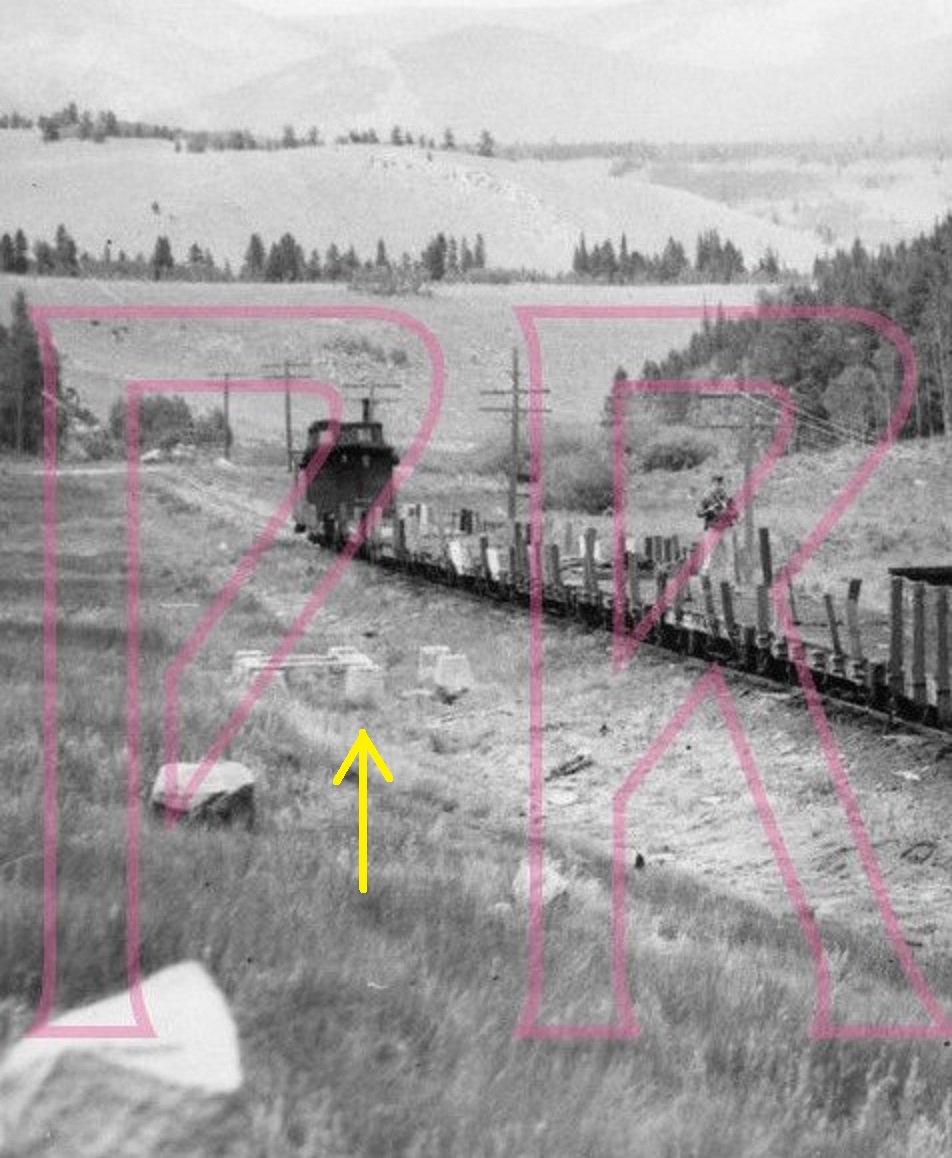 It was always my understanding that C&S road engines and helpers took water on either side of the pass at Webster to the east and Jefferson to the west. I've looked back through all my books, including Poor's station list. No mention of a water tank at this location. Does anyone know of any record of a small water tank at this location?? Rick Steele, any mention of a water tank at Kenosha in the B&B books -- the copy in the "Files" section seems to have disappeared. If these aren't piers for a water tank, what could they be for, located track side in the middle of no where (tho' the scenery is spectacular)?
Jim Courtney
Poulsbo, WA |
Re: Kenosha -- Ghost of C&S "Three Bent Tank"?
|
I was leading to that in a previous thread but no-one responded so I never posted the picture...... http://c-sng-discussion-forum.41377.n7.nabble.com/Coal-and-Water-on-the-South-Park-tp1381p2272.html
UpSideDownC
in New Zealand |
Re: Kenosha -- Ghost of C&S "Three Bent Tank"?
|
This post was updated on .
So you did, Chris. I didn't notice that post at the time.
If there was a tank at Kenosha, it was likely gone before 1918 -- my C&S Valuation Map doesn't show a water tank (or any structure) at that location. And Cliff Mestel's DSP&P B&B Inventory at http://www.railwayeng.com/dspp/rowbuild.htm shows no water tank at Kenosha prior to 1894. I guess I can see the benefit of a water tank in that location, it could help with the watering of helpers at the top of the pass and could be fed by the small lake there. Mac Poor's station list indicates there was a big 47,500 gal water tank located 2.3 miles downgrade to the east at Hoosier, MP 73.83; that would seem to make a water tank at Kenosha redundant. Hoosier tank is another structure that I've of which never seen a photo. I can't think of any other structure that would set on piers right along the side of the tracks. Oh well, just another South Park / C&S mystery I guess.
Jim Courtney
Poulsbo, WA |
Re: Kenosha -- Ghost of C&S "Three Bent Tank"?
|
Playing Devil's advocate here, ... I can think of many times where
I have seen partial building bits that were never completed/used, because plans changed before the structure was completed. Maybe a tank was planned, begun, and never completed ?
"Duty above all else except Honor"
|
Re: Kenosha -- Ghost of C&S "Three Bent Tank"?
|
Like the Rock Wall near Ohio Creek Pass.
|
Re: Kenosha -- Ghost of C&S "Three Bent Tank"?
|
In reply to this post by South Park
I like the never-finished theory. It fits the known facts well.
|
Re: Kenosha -- Ghost of C&S "Three Bent Tank"?
|
If memory serves, that stretch of ROW is still very much present in
the meadow below 285 as it nears the crest of Kenosha Hill, and if memory serves, that is a pretty steep stretch of grade as it goes straight up the valley there .... What comes to mind for me on a thought like this is getting an upgrade train started on such an incline after stopping for water (or any reason). But a water tank would make such a feat a regular standard of operation for any westbound train. Seems like a really odd place to put a tank on those merits. But what do I know ? 
"Duty above all else except Honor"
|
«
Return to C&Sng Discussion Forum
|
1 view|%1 views
| Free forum by Nabble | Edit this page |

